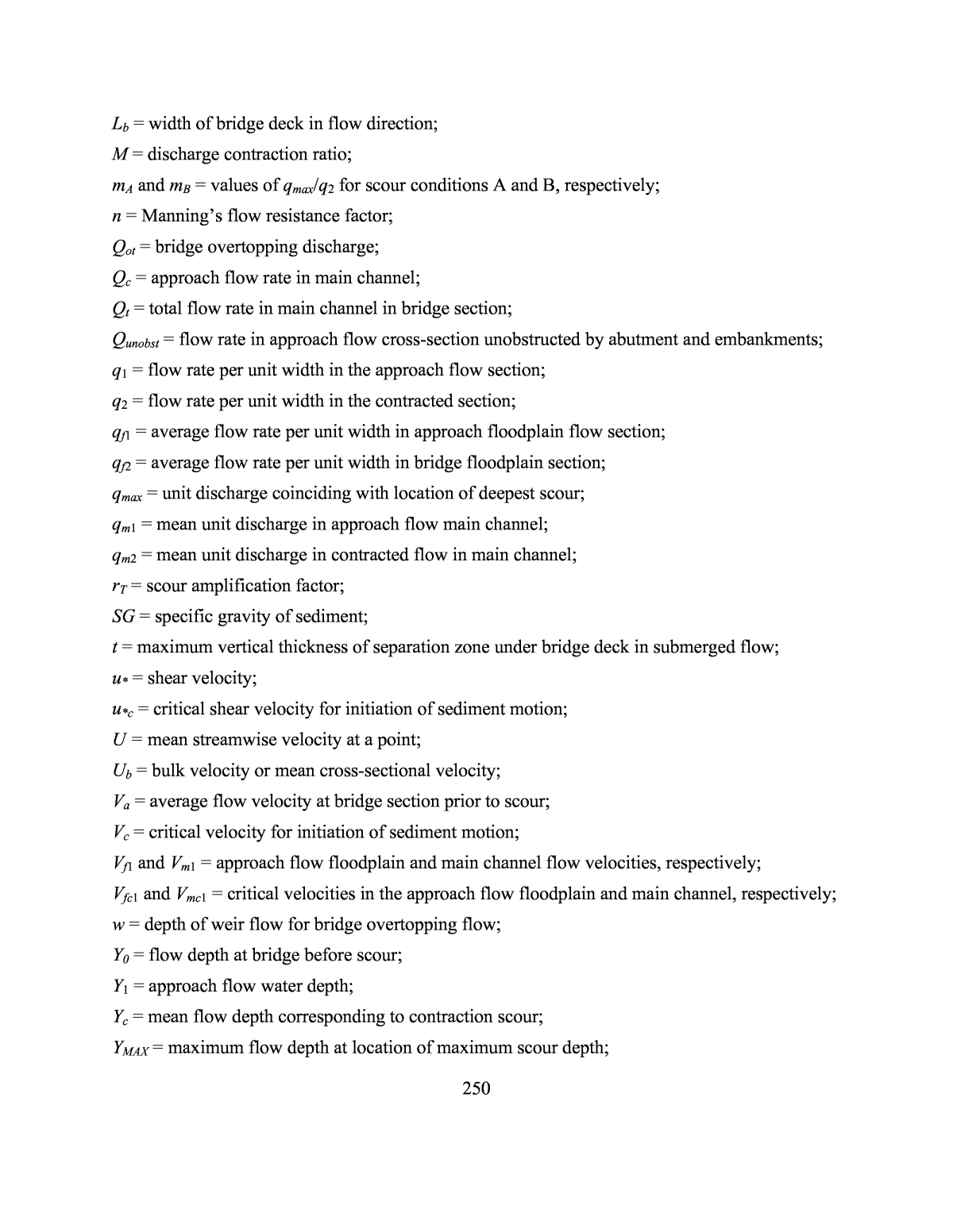


Below is the uncorrected machine-read text of this chapter, intended to provide our own search engines and external engines with highly rich, chapter-representative searchable text of each book. Because it is UNCORRECTED material, please consider the following text as a useful but insufficient proxy for the authoritative book pages.
249 8. LIST OF SYMBOLS AND ABBREVIATIONS SYMBOLS a = pier width; a* = projected width of pier; Bm1 = approach flow main channel width; Bm2 = bridge section main channel width; CAT = coefficient of turbulent influence for abutment Scour Condition A; CBT = coefficient of turbulent influence for abutment Scour Condition B; Cw = weir discharge coefficient; ds = scour depth; d50 = median grain sediment size; F = approach flow Froude number; Fc = critical Froude number for V = Vc; FS = factor of safety; hb = vertical distance from channel bed to low chord of bridge; HWr = head measured above the top of the bridge deck; Kb = turbulent kinetic energy Ks = abutment shape factor; Kθ = flow alignment factor; Kyl = ratio of abutment length to flow depth; KI = approach flow intensity factor; Kd = sediment size factor; KC = channel geometry factor; K1 = pier shape factor; K2 = pier alignment factor; K3 = bed form factor; kp = pressure flow coefficient; kv = velocity adjustment factor; kf = spiral flow adjustment factor; La = length of the approach road embankment to the abutment toe perpendicular to the stream;
250 Lb = width of bridge deck in flow direction; M = discharge contraction ratio; mA and mB = values of qmax/q2 for scour conditions A and B, respectively; n = Manningâs flow resistance factor; Qot = bridge overtopping discharge; Qc = approach flow rate in main channel; Qt = total flow rate in main channel in bridge section; Qunobst = flow rate in approach flow cross-section unobstructed by abutment and embankments; q1 = flow rate per unit width in the approach flow section; q2 = flow rate per unit width in the contracted section; qf1 = average flow rate per unit width in approach floodplain flow section; qf2 = average flow rate per unit width in bridge floodplain section; qmax = unit discharge coinciding with location of deepest scour; qm1 = mean unit discharge in approach flow main channel; qm2 = mean unit discharge in contracted flow in main channel; rT = scour amplification factor; SG = specific gravity of sediment; t = maximum vertical thickness of separation zone under bridge deck in submerged flow; u* = shear velocity; u*c = critical shear velocity for initiation of sediment motion; U = mean streamwise velocity at a point; Ub = bulk velocity or mean cross-sectional velocity; Va = average flow velocity at bridge section prior to scour; Vc = critical velocity for initiation of sediment motion; Vf1 and Vm1 = approach flow floodplain and main channel flow velocities, respectively; Vfc1 and Vmc1 = critical velocities in the approach flow floodplain and main channel, respectively; w = depth of weir flow for bridge overtopping flow; Y0 = flow depth at bridge before scour; Y1 = approach flow water depth; Yc = mean flow depth corresponding to contraction scour; YMAX = maximum flow depth at location of maximum scour depth;
251 Ym1 = initial flow depth in the approach flow main channel; Yf1 = initial approach flow depth on the floodplain; Ï1 = bed shear stress in approach flow; Ï2 = bed shear stress in bridge section; Ïf = shear stress of approach flow in floodplain; Ïc = critical shear stress for initiation of sediment motion; Ï*c = Shieldsâ parameter; Ï = geometric standard deviation of sediment size distribution; ABBREVIATIONS BLA Bankline abutments cfs Cubic feet per second CS Cross Section CSU Colorado State University CWS Clear water scour D/S Downstream DNS Direct numerical simulation F Free flow GT Georgia Tech HEC Hydraulic engineering circular LBS Live-bed scour LES Large-eddy simulation LSA Long setback abutment LSM Level set method for computing position of water surface OT Overtopping flow SO Submerged orifice flow SSA Short setback abutment S & M Sheppard and Melville TKE Turbulent kinetic energy TW Tailwater U/S Upstream UoA University of Auckland VOF Volume of fluid method to find position of water surface
